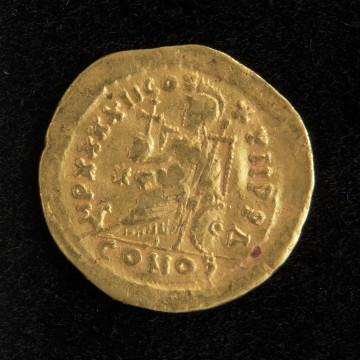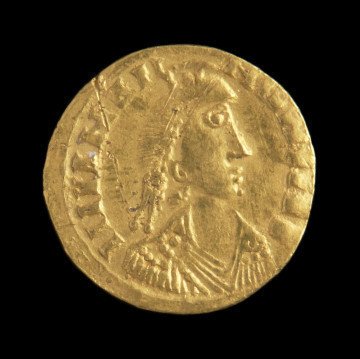
Solidus of Theodosius II
441 — 450
National Museum in Szczecin
Part of the collection: Antiquity
The German (Ostrogothic?) imitation of a solidus of the Emperor Theodosius II from Smołdzino was presumably found at the beginning of the 19th century and handed to the Museum by a private individual. The solidus is the imitation of coins mint in Constantinople in 441–450. The obverse depicts a schematic, barbaric imitation of the Emperor Theodosius II bust facing forward, wearing a diadem on his head and an armour on his chest. On the left side of the figure, there is an upper fragment of a shield. The spear, however, that he usually holds in his right hand, resting it on his shoulder, is missing. On the rim, there is an illegible inscription. The reverse side illustrates a reduced figure of Constantinopolis, facing forward and sitting on a throne. To the left, there is a round shield laid on the ground, leaning on the throne. In the right, raised hand the figure holds the orb and cross (globus cruciger). The left hand holds the long, schematically depicted sceptre (sceptrum). Around the image is the inscription XXXXXX CCXXXX, which supposedly was meant to imitate the original inscription on the rim. Below the figure lays an illegible geometric imitation of the mint mark CONOB. Barbarian imitations of the Roman solidi reached the Western Pomerania with the original solidi. These were the first attempts of money production done by the Visigoth and Ostrogoth tribes which led to the collapse of the Western Roman Empire.
Monika Witek
Author / creator
Dimensions
cały obiekt: diameter: 21 mm
Object type
exchaneg media; money; coin; solidus
Technique
forming; punching
Material
gold
Creation time / dating
Creation / finding place
Owner
Muzeum Narodowe w Szczecinie
Identification number
Location / status

441 — 450
National Museum in Szczecin

476 — 491
National Museum in Szczecin

425 — 455
National Museum in Szczecin
DISCOVER this TOPIC
National Museum in Lublin
DISCOVER this PATH
Educational path